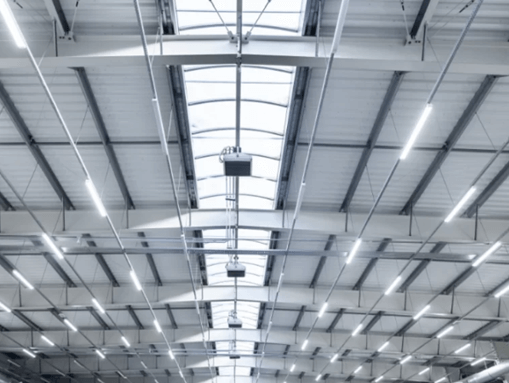Light Emitting Diodes (LED) lighting is often hailed as wonderful energy-efficient illumination for large spaces.
Known as a low heat emitting form of light, LEDs are extremely practical in cold storage facilities and outdoor applications.
However, LEDs can oftentimes cost as much as four times the investment of other types of lighting such as fluorescent, incandescent or high-intensity discharge (HID) lamps.
So, whether to choose LED lighting in your facility depends on a number of competing factors.
Below we debunk some of the common myths surrounding LED lights and provide tips for lighting in your warehouse.
LED Industrial Lighting Myths and Facts
Myth 1: Switching to LED Lighting is Expensive
Fact: LED lights are more expensive in upfront costs. However, if you are planning to be in your facility for the long haul then you will be taking advantage of substantial energy savings and longer lifetime value.
Myth 2: LED Lights Don’t Save Energy
Fact: When compared to incandescent or fluorescent lights, LED lights are far superior. According to The Department of Energy on average, based on 20 hours of usage a day, LED lights annual energy cost is about $20 whereas an incandescent light is $96. That adds up quickly in a facility that has hundreds of light bars.
Myth 3: LED Lights Contain Hazardous Materials
Fact: LED lights contain absolutely zero mercury and are 95% recyclable.
Myth 4: LED Lights Don’t Work Well in Cold Storage Facilities
LEDs only emit heat at around 120 degrees. With less heat being produced, your storage space doesn’t have to work as hard to keep temperatures cool. In turn this saves you more money in combination with the LED energy savings.
Myth 5: LED Lights Are Harmful to your Eyes
Fact: LED lights are not focused at a single spot, like lasers and their intensity is comparable to incandescent bulbs, HID, and fluorescent lights. In fact, LEDs use the same amount of blue light that our smartphones, computers, and tablets use.
Myth 6: LED Lights Only Have Bright Color Options
Fact: LED lights have dimmable features and come in several options of color. Click here to view the wide variety of wattage output and colors.
Tips for LED Lighting in a Warehouse
Long Term Investment: One of the first things to weigh when comparing LED lighting to other options is the return on investment time you have in mind for operating and maintaining your facility. If it is a new facility and you will be there a long time, investing in LED from the start is a great idea. However, the calculations for long term savings do not necessary correlate if you are retrofitting your space with LEDs or using a facility for a limited amount of time.
Application: LED lighting is available for use in most every type of function, however its performance will vary based on application and environmental conditions. The general rule is that LED lighting is regarded as a good value in outdoor or cold storage settings. Because they produce less heat and utilize less energy, installing LED lights in low temperature situations will work very well over time.
Energy Savings: Well-designed LED fixtures can create more illumination with less wattage of delivered light. This translates into lower electric bills and a quicker payback timeframe for the initial lighting investment. In states where energy policies are restrictive and limited electric is accessible, LEDs offer a valid option.
Environmentally Friendly: Even though the aluminum heat sinks of LEDs can take up more space in landfills at the end of their product life cycle, LEDs are viewed as more environmentally friendly from the standpoint of using less energy consumed during their operational life.
Quality of Light: Color rendition of LED lighting is not identical to incandescent lamps and can be a reason to not use them in indoor lighting, especially if the Color Rendition Index (CRI) needed is upwards of 80. Nonetheless, the coloring render is adjustable in LEDs by lumen output, to achieve the desired color index level.
Maintenance: LED lighting fixtures are relatively low maintenance over their thousands of hours of operation use. Of course, the maintenance aspect of LEDs must be compared to the initial cost and installation of the lighting system. However, if this issue is of great concern, LEDs reduce the normal maintenance activity of bulb and component replacements.
Because lighting sources are very hard to compare as apples to apples, the best strategy is to do an analysis with your local lighting expert to understand whether LEDs are the best fit for your facility.
FAQ
Are LED Lights a Fire Hazard?
No, LED lights are not a fire hazard because they are highly efficient and emit a low amount of heat.
Can you Leave LED Lights on All Night?
Yes, LED lights are extremely long lasting and are ideal for leaving on for longer periods of time due to their low power usage and low heat output.
How Long Do LED Lights Really Last?
LED lights will typically last 25,000-50,000 hours depending on brand.





